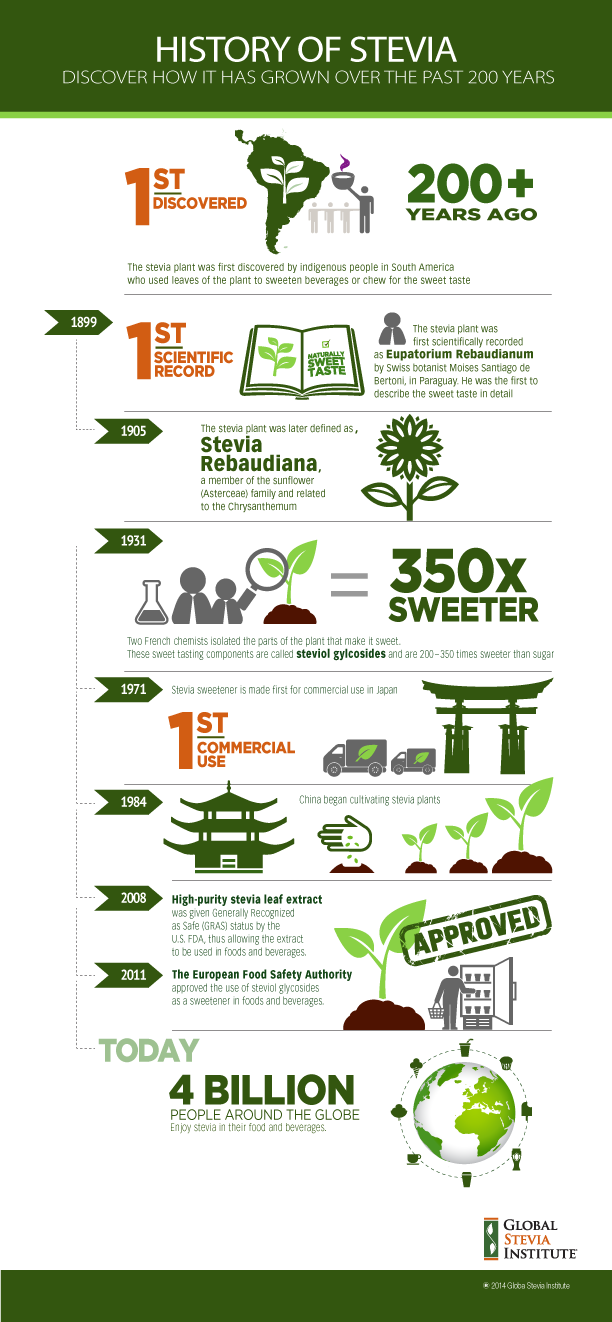Stevia: The natural truth and myths
We all want to eat more naturally, and it would appear that the sweetener stevia, sourced from a plant, fits the bill. But, is it as natural as all that?
First, a few facts about stevia from the Global Stevia Institute:
- Indigenous South Americans discovered stevia and chewed the leaves
 for the sweet taste.
for the sweet taste. - In 1905 scientists classified the plant as stevia rebaudiana, a member of the sunflower family, related to the chrysanthemum flower.
- In 1931 chemists isolated the sweet-tasting compounds called steviol glycosides.
- Japan was the first nation to approve stevia sweetener for commercial use in 1971.
- In 1984 China began cultivating stevia plants, and remains the number one producer. All the big commercial producers source their stevia from China.
- In 2008, the U.S. Food & Drug Administration (FDA) approved stevia extract as GRAS (generally recognizable as safe) to use in foods and beverages; in 2011 the European Food Safety Authority approved steviol glycosides as a sweetener in foods and beverages.
- We buy stevia in powder or liquid extract form, and it is 200 to 400 times
 sweeter than sugar (sucrose). It is classified as a “no-calorie” sweetener.
sweeter than sugar (sucrose). It is classified as a “no-calorie” sweetener.
How Natural Is Processed Stevia?
You might think that packaged foods labeled “natural” are somehow purer or healthier, but don’t bet on it. It’s natural to assume that “natural” means minimally processed and sourced from organically grown plants, but the lack of standards in most countries means that the term assures nothing. Yes, in some countries the label “natural” is strictly defined and enforced. But in others, such as the United States, it is not — read the ingredient labels so you know exactly what you’re eating. For example, milk-substitutes like rice milk and almond milk are mostly water and processed with thickeners like carrageenan, which could cause gastric upset. Energy bars get slapped with the “natural” label, and are typically full of added sugar, rice flour and undefined “natural” flavors. Here in Ecuador, you can buy many packaged and processed foods that are made in the U.S.
The packaged white stevia powders and liquid extracts available in supermarkets are highly refined chemical extractions. It’s very important to read the ingredient label, since most stevia products are packaged with fillers, bulking agents and additional sweeteners such as dextrose (a form of sugar) to “balance” the taste.
The Best Stevia, and the rest.
Supermaxi is the perfect place to do a little stevia sleuthing. While many varieties say “natural” on the front of the package, savvy shoppers never read the front-of-the-package claims — they always flip the package over and read the ingredient list first. Ingredients are listed in descending order of weight or volume — the ingredient listed first is the primary ingredient, followed by lesser ingredients. (Bring your magnifying glass — I’m not sure if the print is getting smaller, or my eyes are getting older — probably a little of both.)
The Most Natural Stevia Is…?
Whole-leaf stevia. The stevia plant is super-easy to grow and sold in mercados and nurseries around Cuenca. Dried stevia leaves are also sold in mercados. When raw and unprocessed, green stevia leaves taste strongly of licorice and many observe this distinct flavor even when the leaves are dried and processed.
 Supermaxi also carries dried stevia leaf, but you’ll have to do a deep knee bend to find them, as they’re located all the way on the bottom shelf. Ingredient list? There should only be one ingredient: natural stevia leaves.
Supermaxi also carries dried stevia leaf, but you’ll have to do a deep knee bend to find them, as they’re located all the way on the bottom shelf. Ingredient list? There should only be one ingredient: natural stevia leaves.
For more feedback on sourcing natural stevia in Cuenca, I reached out to my Facebook friends.
One reports buying a stevia plant at the weekend market located on Calle Max Uhle, across from the electric company. But how to use it, I asked?
Facebook friend Taylor says she buys dried leaves in the mercado, steeps them in vodka for 24 hours, boils off the alcohol, and places into a dropper bottle. She uses a couple of drops to sweeten tea and other beverages, and says it’s not bitter at all.
FB friend Larry posted a link to a video that shows you how to make your own pure stevia and liquid stevia.
By the way, if you are allergic to ragweed, marigolds, daisies and related plants, stay away from unprocessed stevia — it’s all in the same allergen family.
The Rest
Packaged brands are listed in order of acceptability (this is my opinion). Please feel free to post your own preferred brands or recipes for making your own stevia sweeteners in the comments below.
Article continues below the graphic.
 Stevia Life: The front of the box states Dulzura 100% Natural, which I believe translates to 100% natural sweetness. Well…gee…it’s not 100% natural, since the first ingredient listed is Sólidos de Maíz, a corn-based filler. The second ingredient is stevia extract. This blend has no “natural” flavors added.
Stevia Life: The front of the box states Dulzura 100% Natural, which I believe translates to 100% natural sweetness. Well…gee…it’s not 100% natural, since the first ingredient listed is Sólidos de Maíz, a corn-based filler. The second ingredient is stevia extract. This blend has no “natural” flavors added.
Stevia Sweet: Endulzante Liquido: The front package offers a sweet illustration of a hummingbird hovering over a flower, as if by purchasing this product you’d be getting nectar from nature. The front label reads, Endulzante con Stevia de origen natural…a natural stevia sweetener. But get out your magnifying glass, and find the ingredient list. Agua purificada, glicerina, stevia extracto seco, acido citrico, citrate de sodio, sorbato de potasio, benzoate de sodio. Purified water, glycerin, stevia extract, and… the rest of the ingredients are preservatives. As for glycerin, this is typically vegetable glycerin, a sweet substance derived from palm or coconut oils and used as a replacement in herbal and botanical extracts. I haven’t seen any health negatives associated with consuming it.
Stevia Sweet: Endulzante en Polvo: This powdered version contains man-made maltodextrina first, then stevia extracto seco, inulina, and taumatina. Maltodextrina (maltodextrin) is a polysaccharide that is used as a food additive. Produced from starch by partial hydrolysis, it is usually found as a “white hygroscopic spray-dried powder” (Wikipedia). Stevia extract comes next, then inulin (a plant fiber that many find hard to digest), and something called taumatina, or thaumatin, a sweetener and flavor modifier derived from the katmenfe fruit found in West Africa (I had to look this up!). So you can see that this product contains quite a few ingredients besides stevia.
Nature’s Heart: The front-of-the-box label says Endulzante con stevia en polvo: libre de gluten – libre de azúcar. A powdered sweetener, gluten-free and sugar-free. Sugar free? Hmmm. Let’s flip that box over and read the ingredients.
The first ingredient listed is dextrose, which is the commercial name for the crystalline glucose produced from starch, typically produced from cornstarch. Although 20% less sweet compared to sucrose, it is a form of sugar. Following dextrose is stevia extract, then dioxide de silicio, described as a “anticompactante”, an anti-clumping ingredient, which could be irritating to some people’s digestive tract. The last ingredient is sabor natural, or natural flavors. But no one is saying what the “natural flavors” are.
Coke Life with Stevia?
Coca-Cola also produces a soft drink with rebiana called “Coke Life with Stevia.”
The DailyMail.com (Australia) includes a comprehensive review of sugar content of popular sodas, energy drinks, and enhanced waters, plus a comment on Coke Life with Stevia:
Health experts have accused Coca-Cola of ‘health washing’ consumers with the launch of its new ‘lower-calorie’ soft drink as it still contains the full amount of an adult’s recommended daily allowance of sugar.
Article continues below graphic.
 The soft drink giant’s latest product, Coke Life, is partly made from a naturally sweet plant called Stevia, in a bid to target health conscious soft drink lovers.
The soft drink giant’s latest product, Coke Life, is partly made from a naturally sweet plant called Stevia, in a bid to target health conscious soft drink lovers.
But a 330ml can of Coke Life still has 24g of sugar, equivalent of six teaspoons and 90 calories.
When compared to a 330ml can of regular Coke which has 35g of sugar, equivalent of almost 10 teaspoons of sugar and 139 calories, that is 35% less sugar.
The World Health Organization (WHO) recommends that adults of normal body mass index only eat 25g (6 teaspoons) of sugar in total per day.
University of Sydney nutritionist Dr. Kieron Rooney told Daily Mail Australia: ‘Coke Life should not be considered a healthy option… it should not even have a seat at the table. This is health washing, yes it is less sugar than the original but that is still an excessive amount — it is still a sugar sweetened beverage and is no way part of a healthy life or lifestyle.’
I like the term “health washing”, akin to brain washing, I’d think. When you’re offered the same misinformation and media marketing unremittingly, it takes some effort to ignore and think critically about it.
Regarding corn-derived ingredients including dextrose, corn solids, cornstarch or corn syrup: most corn produced in the U.S. is genetically modified and any processed foods imported from the U.S. containing these ingredients is likely to be made from GMO corn.
If it is important to you, all of Coca-Cola’s colas and most of their soft drinks are sweetened with sugar sourced from genetically modified corn or beets.
Read Coca-Cola’s position statement on GMOs here. Read product information on Coke Life here.
The Takeaway
Stevia may sound more natural than other artificial sweeteners, but when you’re buying it as a processed powder or liquid extract it’s not as natural as all that.
 Just like any of the other “artificial” sweeteners on the market, processed stevia is safe to consume in recommended amounts, but constantly drinking sweetened drinks may cause your taste buds to continually crave sweetness.
Just like any of the other “artificial” sweeteners on the market, processed stevia is safe to consume in recommended amounts, but constantly drinking sweetened drinks may cause your taste buds to continually crave sweetness.
Which is why some experts advise to stop adding sweeteners, whether it is a “natural” or “artificial” sweetener to everyday foods like cereals and especially beverages like coffees, smoothies, and juices.
If you want something sweet, plan for it, and make it worth it. Not fake sugar, just the real deal. Fit something sweet as a treat into your balanced diet, and make it occasional (which doesn’t mean daily).
If you do like a certain brand of stevia, want to recommend a favorite vendor, or have a recipe to share, scroll down and post in the comments below.
For more about the varieties of natural sugars and the growing number of artificial sugar substitutes, read my column in CuencaHighLife.com.
Sources
CuencaHighLife.com. The science of sweet: The varieties of sugar and the growing number of substitutes. https://www.cuencahighlife.com/the-science-of-sweet/
DailyMail.co.uk. Coca-Cola accused of ‘health washing’ because a single can of Coke Life maxes the daily recommended amount of SIX teaspoons of sugar. http://www.dailymail.co.uk/news/article-3018850/Coca-Cola-accused-health-washing-single-Coke-Life-maxes-daily-recommended-SIX-teaspoons-sugar.html
Fooducate. Warning: Stevia’s Sweeteners May NOT Be as Natural as You Think. http://blog.fooducate.com/2013/07/20/warning-stevia-sweeteners-may-not-be-as-natural-as-you-think/
Livestrong.com. How to use fresh stevia leaves. http://www.livestrong.com/article/286554-how-to-use-fresh-stevia-leaves/
Livestrong.com. What is dextrose in food? http://www.livestrong.com/article/274155-what-is-dextrose-in-food/
Time.com. Better than Sugar? 5 Natural Sweeteners Demystified. http://healthland.time.com/2012/02/29/better-than-sugar-5-natural-sweeteners-demystified/
WholeLifestyleNutrition.com. How to Make Your Own Pure Stevia and Liquid Stevia Part 2. https://wholelifestylenutrition.com/videos/how-to-make-your-own-pure-stevia-liquid-stevia-part-2/




















